Roebuck: 'Senna was the most complex character I ever encountered in F1'
Our editor-in-chief recalls Ayrton Senna as a talent feted for F1 greatness - but also as a driver with a dark side
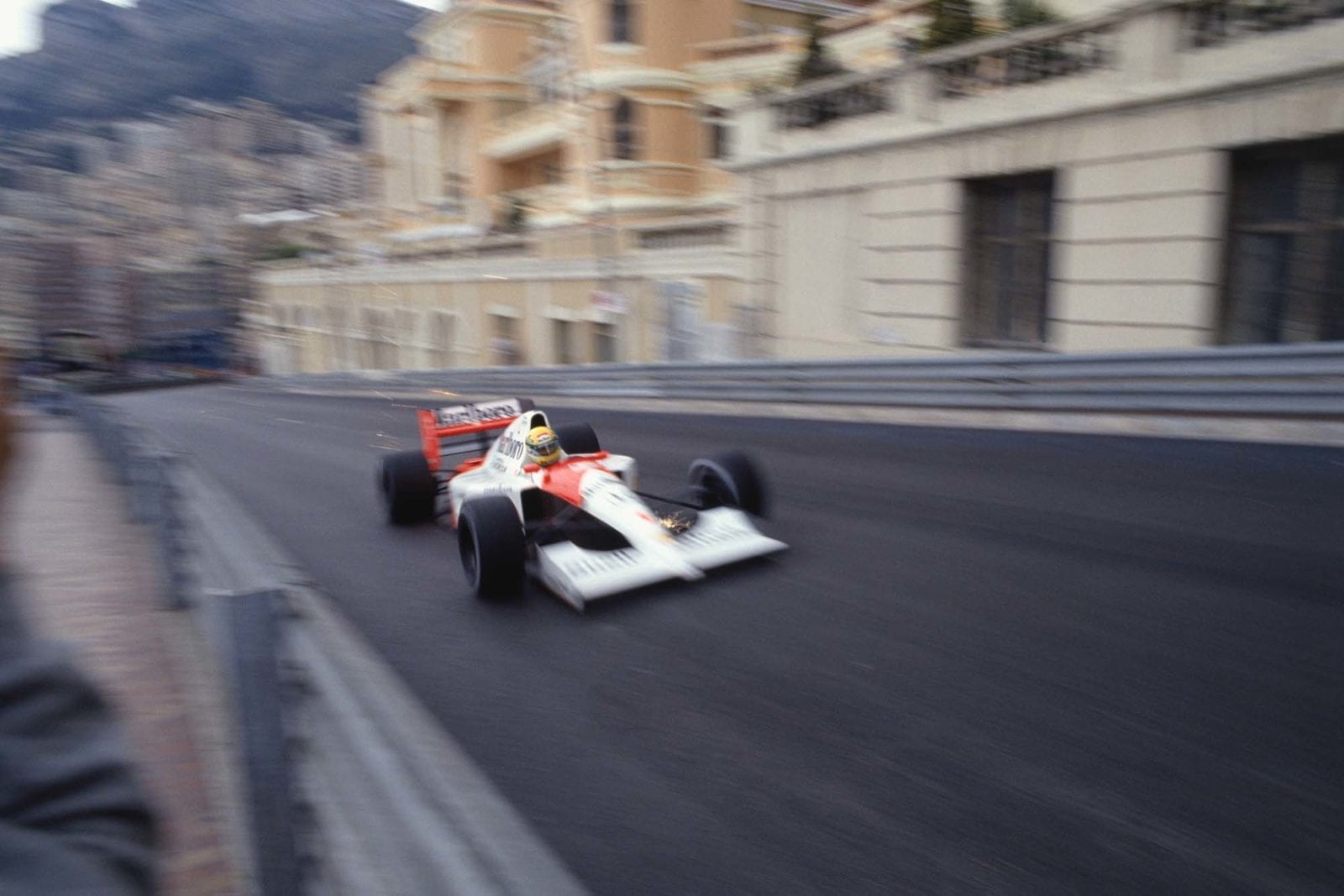
Motorsport Images
For a few days after seeing Senna, I couldn’t get the man out of my mind, and perhaps not surprisingly so. I had, after all, been present at all but a handful of his 161 Grands Prix, and inevitably the movie brought that time alive again, releasing a deluge of memories.
I thought back, for example, to a morning in the spring of 1983, when a phone rang in the Autosport office and I picked up. The voice at the other end asked for Jeremy Shaw, then the magazine’s Formula 3 correspondent. “He’s not here — I’ll give him a message,” I said. “Who’s calling?”
“Ayrton Senna,” said the voice. “Who’s that?” I told him. “Ha! We should meet, have a meal. I want to talk to you — I’m going to be in Formula 1 next year…”
And so he was, with Toleman. At Kyalami, his second race, he was sixth, but so unfit — in F1 terms — that he had to be lifted from the car. This, like virtually every other weakness in his game, he would swiftly address.
Everyone remembers Monaco that year, where — in torrential conditions — Senna was on the point of taking the lead from Alain Prost when the race was stopped. There’s no doubt it was a remarkable drive, although easily forgotten is that another rookie, the lamented Stefan Bellof, was catching both of them when the red flag came out.
From the outset Ayrton behaved like a man who belonged in F1. And from the outset, too, there was about him an indefinable quality not quite earthly, which borrowed not only from his driving but also from his voice, his manner, his whole being. Undoubtedly this unsettled his rivals, but what worried them more was the uncomfortable certainty that soon this arriviste was going to be the best.
The early race that stays with me more than Monaco came in 1985, at Estoril, where Senna — now with Lotus — was so dominant in the rain that one thought of Jimmy Clark. First pole, first victory, and Denis Jenkinson was as impressed as anyone: “Villeneuve all over again, isn’t it? A racing driver who’s ahead of his car…”
The next day Senna flew back to London — commercial — and found himself sitting next to none other than DSJ to whom he’d never spoken, for while Jenks enjoyed close contact with F1 engineers, like Patrick Head, he had long since adopted a different policy with drivers: “Don’t talk to them any more — waste of time…”
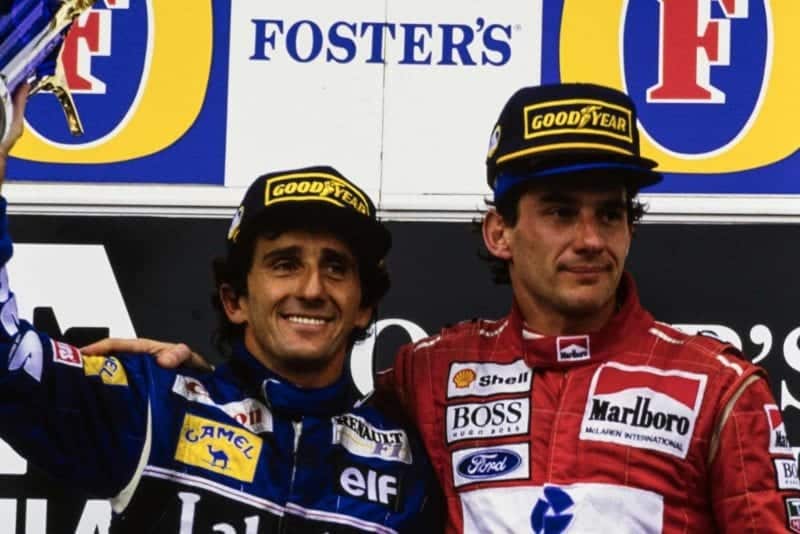
The last podium, at Adelaide ’93, where an emotional Ayrton bade farewell to his great rival
Motorsport Images
Senna introduced himself, however, and they chatted all the way back to Heathrow. By the time the aeroplane touched down, Jenks had a new hero.
When I talked to Ayrton about that race in Portugal, he was disarmingly frank. “People seem to think I made no mistakes — but I’ve no idea how many times I went off! Once I had all four wheels on the grass, but the car came back on the circuit, and everyone said, ‘Fantastic car control!’ It was just luck…”
Well, maybe on that occasion, but it was a drive for the gods, and would hold a special place in Senna’s affections. Eight years on, in similar conditions, he would win for McLaren at Donington, his opening lap as mesmeric as any the sport has known, but Ayrton scoffed at those who thought it his greatest drive: “No way! I had traction control! It was a good win, sure, but compared with Estoril ’85 — turbo engine, a lot more power, no traction control, normal gearbox — it was nothing, really…”
Just as no three-year contract had been enough to keep Senna at Toleman for more than one season, so it was always clear that Lotus — a couple of wins a year was never what Ayrton had in mind — was no more than a staging post. What he required was the best team, the fastest car, and that meant McLaren, whose new partnership with Honda coincided with his arrival in 1988.
If ever F1 has had a ‘super team’, this was surely it. “Think about it,” Bernie Ecclestone said to me, “Prost, Senna, Honda… with that lot you could start a bleedin’ war!”
So you could, and the two greatest drivers on earth, facing limited opposition from elsewhere, ultimately did just that — between themselves. It would end only when Prost retired at the end of 1993.
When first the news broke that Senna had signed for McLaren, many wondered at the wisdom of it. “I’m curious,” said John Watson, “to see how Senna will fit into the McLaren machine, as he represents their long-term driver future. This season, competing with Prost, could make him into an old man…”
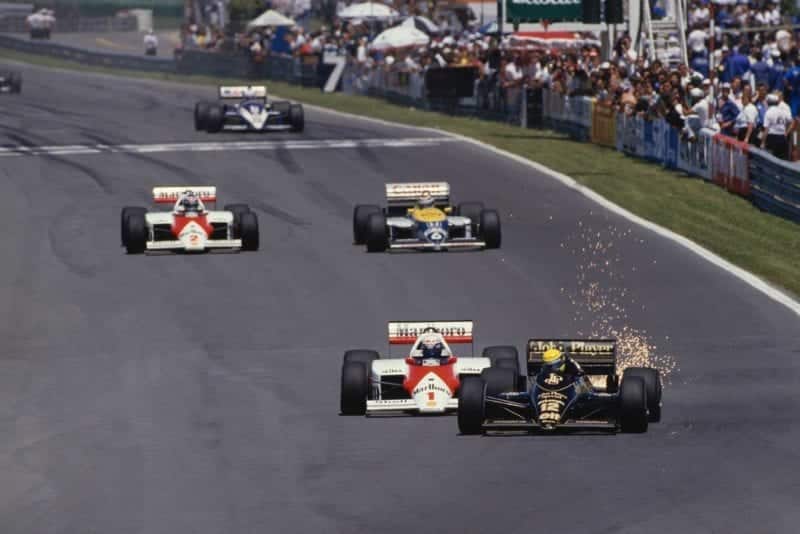
Senna keeps Prost in check at Montreal ’85
Motorsport Images
Not a few agreed, for Alain was widely acknowledged as the best — which was why, of course, Ayrton had him in the cross-hairs from the outset. Soon he confirmed that — day for day — he was quicker than anyone, particularly in qualifying, and Prost could live with that, for he was better than anyone at setting up a car, unequalled when it came to driving and thinking at the same time.
His dislike of Senna’s ruthlessness on the track, however, was profound. “Ayrton had his rules, and he believed in them, and that was it. In his own mind he was always right — on the track and off. No, I didn’t like a lot of the things he did — but then, how often was he sanctioned? Never. So, in a way I can’t blame him.”
The most extreme moment came in 1990, after they had ceased to be team-mates. At Suzuka Senna simply took aim at Prost’s Ferrari into the first corner — the telemetry showed that he never lifted — and speared into it at 150mph. For me, this remains the most reprehensible incident ever seen at a race track: immediately behind them were 24 other cars, and Alain’s rear wing — sheared off in the impact — could have come down anywhere.
“Alain was the best — which was why Ayrton had him in the cross-hairs from the start”
This was Senna at his most absolute, his most terrifying, and even his own team found it difficult to defend him. After the race I came across a couple of engineers, formerly colleagues, as they sifted through the day’s events. “Well,” said Tim Wright of McLaren, “that was a bloody waste of everyone’s time, wasn’t it?” “Yes,” shrugged Steve Nichols, now with Ferrari. “Still, er, congratulations…”
Someone else piped up, “Ron [Dennis] says it would never have happened if Ayrton had been allowed to have pole position on the left side of the track…” At that Nichols erupted: “Jesus Christ, where the hell does this end? It wouldn’t have happened, either, if they’d just given Senna nine points and not run the goddam race!” Wright stared at the ground.
“It was that day,” said Jo Ramirez, who somehow contrived to remain a friend of both drivers, “that made me realise Ayrton was capable of doing whatever was necessary to secure the title. Ron was the only McLaren man to congratulate him…”
Prost spoke about it quietly. “OK, he’s won the title, and he’s welcome to it — but if what he did is acceptable then racing is finished, dead. This is supposed to be sport, not war…”
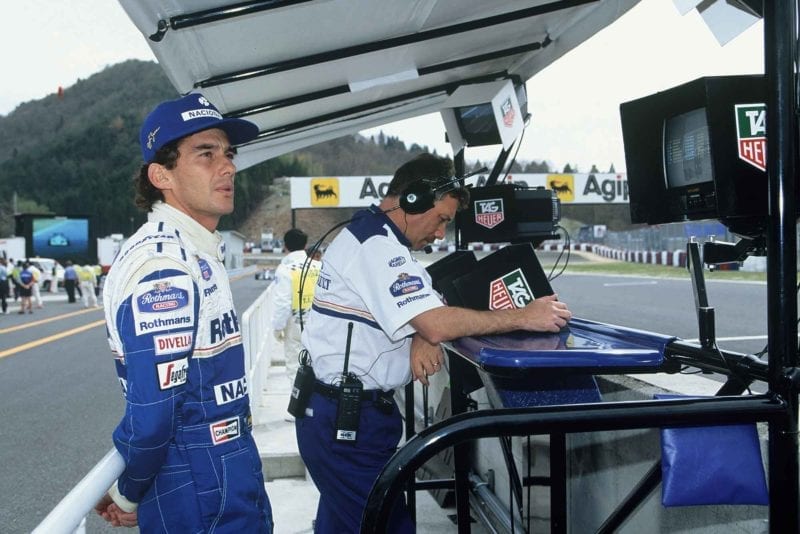
Senna, seen here at Aida in ’94, seemed a troubled man in his final few races with Williams
Motorsport Images
Senna said that Prost had left a gap, and he had simply gone for it, but by the time of Suzuka a year later he admitted that he had indeed taken his rival out. The blame, though, lay elsewhere, he claimed, for he had requested that pole position be moved from the right to the left side of the track, and insisted that this had been prevented only by FIA president Jean-Marie Balestre — a fellow countryman of Prost.
That being so, he clearly felt he had carte blanche to respond as he saw fit. “If pole had been on the left,” he told us, “I’d have made it to the first corner in the lead, and then we could have had a clean race. I said to myself on Saturday, ‘If, at the start, because I’m in the wrong place Prost beats me off the line, at the first corner I’m going for it — and he’d better not turn in ahead of me, because he’s not going to make it…”
So now we knew: the plan may have been hatched in emotion and anger, but it was carried out in cold blood.
Ayrton effed and blinded his way through the press conference, and a couple of weeks later, in Adelaide, a statement was issued: “I now feel that my remarks concerning Jean-Marie Balestre were inappropriate, and that the language used was not in good taste.”
That smacked more of Woking than Sao Paulo — the giveaway was ‘inappropriate’ — and no one took any notice of it, for all who had been at Suzuka knew that Senna had been speaking from the heart. Unpalatable it may have been, certainly in part, but assuredly it was impassioned and free of the political correctness which now infects Grand Prix racing.
The Senna movie opened in certain countries some time ago, and the DVD is already available in countries such as Brazil and Italy. I looked at the buyers’ reviews on Amazon, and one, from a consummate Senna fan, read thus: ‘It was well put together and honest — although it didn’t show much of Senna’s dark side, which we all knew he had. It is not a film trying to prove how good or bad he was; it shows how dedicated, passionate and humble he was. You don’t have to be a Senna fan to enjoy this. You just have to enjoy good documentary making.’

Senna during his controversial outburst at Adelaide ’91
Motorsport Images
If, as the reviewer says, there is little coverage of Senna’s ‘dark side’, so we should remember that many more days were bright — blinding, even. I think of him, for example, at Monaco, when the left flick into the swimming pool area was marked not by a painted line, but by solid masonry. To stand right there, to watch him on qualifying tyres, boost up, was to understand the meaning of commitment, nothing held back at all. It was genius, and it made you tremble.
I think of Ayrton, too, at Adelaide in November 1993. Through the practice days he worked away with the McLaren engineers, as usual, then took pole, then won the race. Yet another victory in the familiar red-and-white.
Prost finished second for Williams-Renault, but this had not been after one of their epic battles, for Alain, already confirmed as World Champion for the fourth time, was retiring, albeit through circumstance rather than choice.
Renault were big spenders in those days. Having won the World Championship with Nigel Mansell in 1992, it was always likely that they would do it again with Prost in ’93, yet in the middle of the year they decided they wanted more yet: they wanted Senna for ’94, theoretically as Prost’s team-mate, although they must have known that Alain, once burned, would never agree. Thus Prost departed, the second season of his contract paid off, and Senna made the move to Williams-Renault. Big spenders, as I said.
Senna and Prost had also finished 1-2 in the penultimate race, Suzuka, and afterwards Alain suggested that, as this might be their last press conference together, it might be a good moment publicly to shake hands, even exchange helmets. The response was noncommittal, which Prost took as tacit agreement, but at the conference Senna didn’t so much as look at him.
The thing wasn’t done, you see: there remained one more race — and Ayrton, as ever, was absolute. Two weeks later, on the Adelaide podium, he was all smiles, putting his arm round Alain, joking with him that now he was retiring he was going to get fat, and so on. “In Adelaide it was his idea,” Prost smiles today, “and therefore it was OK! Still, it was nice to finish like that…”

Senna and Prost vie for position, a familiar sight for several seasons
Motorsport Images
At the post-race concert Tina Turner had Senna up on stage as she sang Simply The Best, and there was even more than usually an end-of-term feel about the day. In point of fact, it was the end of an era, bringing to a close not only Prost’s career but also the sport’s most tumultuous feud. Senna’s emotions were mingled — joy from winning the race, but also a certain melancholy from knowing this was the last time around with McLaren. Ahead was a new life with Williams — and without Prost, always the mainspring of his motivation.
When next I saw Ayrton, at Interlagos in March 1994, I sensed a man somewhat changed, and there was more to it than seeing him in an unfamiliar pit, wearing blue rather than red. Of course he was getting accustomed to a team with a very different culture, but suddenly he looked every one of his 34 years, and somehow not at peace with himself.
The Williams FW16 didn’t help, of course. Having watched Mansell and Prost waltz to successive championships, Senna had assumed that he, too, would be handed a title-winning car. But in its early guise the FW16 was wayward, and no match for the Ford-powered Benetton B194 — or, at least, the one driven by Michael Schumacher.
“When next I saw Ayrton, I sensed a man changed…He looked every one of his 34 years”
For all that, in each of his races with Williams — Interlagos, Aida, Imola — Senna put the car on pole. “Williams weren’t on pole for those three races,” said David Brown, his race engineer. “Ayrton was…”
In Brazil Senna, chasing Schumacher, uncharacteristically dropped it, and in Japan was turfed off at the first corner. Rather than walk back to the pits, though, Ayrton stayed to watch for a while, and returned with the conviction that some Benettons were more equal than others. And the more equal one won, as it had at Interlagos.
This was to weigh considerably on Senna’s mind. As one who savoured what he called ‘pure’ racing cars, Ayrton had been delighted by the newly-introduced ban on ‘gizmos’ such as active suspension, traction and launch control, ABS, and so on. But he was unconvinced that Schumacher’s Benetton was quite as ‘back to basics’ as it might have been.
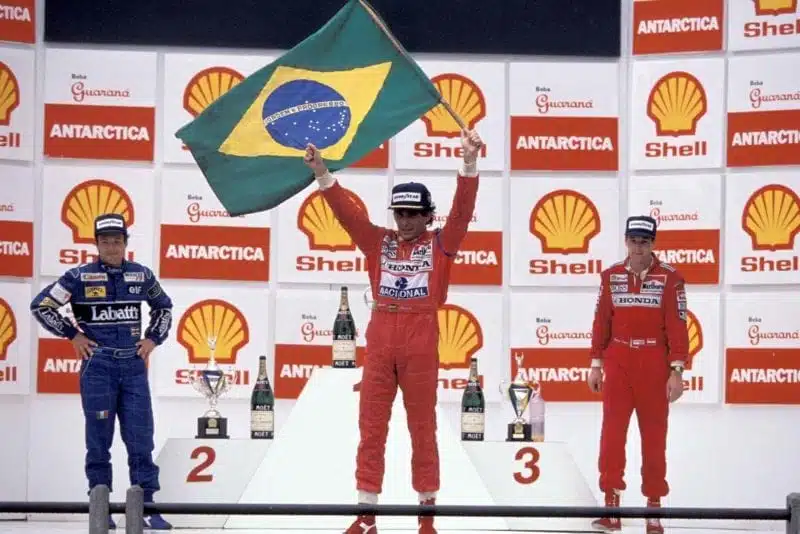
Few things meant more to Senna than winning his home race, seen here at Interlagos ’91
Motorsport Images
None was closer to Senna than Professor Sid Watkins. “He was very upset about those races,” said the Prof. “There’s no doubt he felt very much pressured that he had to win at Imola — in fact, I believe he felt trapped by every aspect of his life at that time. I honestly think he would have liked to step back — that was the impression I’d been getting for a while.
“I always worried for Ayrton. He’d be leading easily, and I’d be sitting there in the medical car, willing him to slow down a bit — but he couldn’t help himself, and that was his main fault as a racing driver, in my opinion. I used to tell him that the clever driver is the one who wins by taking the least out of himself and the car, and he’d say, ‘Yes, I know you’re right — every time I go past your car I remember what you said, and I feel guilty about it. But by the time I get to the next corner, I’ve forgotten…”
The horror of that Imola weekend will for ever stay with anyone who was there, and none more than Prost, for in the last weeks of his life Senna had several times phoned, seeking his help and advice in matters of safety. “We had agreed to talk about it at Imola,” said Alain, “and that made that weekend somehow even more horrible. Ayrton was talking all the time about safety, and he was much softer than before — for me, he had changed completely. He seemed very down, and without the same power as before. We talked on the Friday, and then again on the Sunday morning — he was really trying to be friendly. He wanted help — he needed someone, that was obvious…”
“We always had a great respect for each other as drivers. I don’t think either of us worried too much about anyone else” Alain Prost
Could they in time have become friends? “Mmm, it’s not impossible,” said Prost. “In spite of everything, we always had a great respect for each other as drivers, and that was the most important thing. I don’t think either of us worried too much about anyone else.”
Senna was indeed a special force in motor racing, and I suspect he would have been that way in any walk of life he might have chosen. Without a doubt his was the most complex character I ever encountered in the sport, and not without its contradictions. As a driver he was utterly uncompromising, and off the track, too, could be cruel if he felt the circumstances demanded it. But he could also be gentle and disarming, and there were many tales of his private kindnesses: the man who would — literally — push a rival off the track would also weep at a small gift from a shy fan.
The new film is a fine and moving tribute to a poet of a racing driver, but Ayrton Senna was no saint. There was much more to him than that.
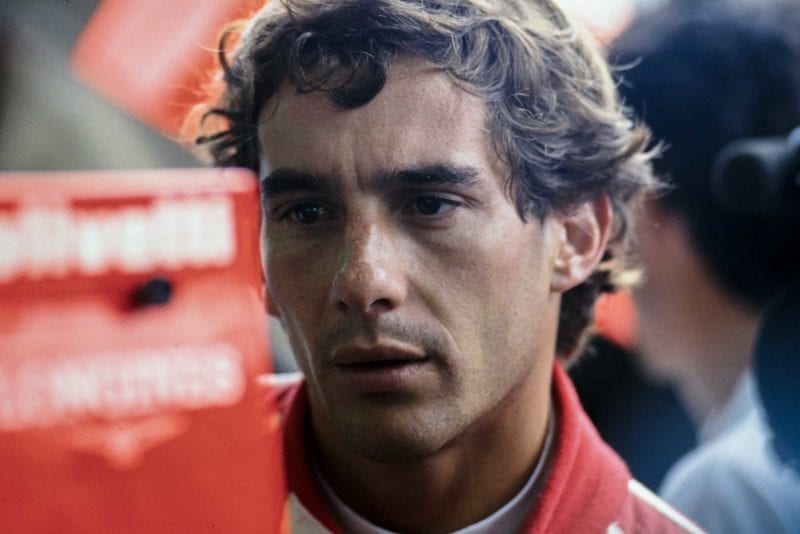
Senna stays meticulous as ever
Motorsport Images
